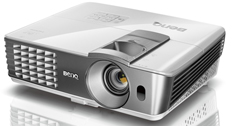
Introduction to the BenQ W1070 Projector
I’ll be blunt: I don’t like 3D. I’ve never been able to justify paying extra to see it in the theater, and at home it has always left me cold. Most implementations give me a headache almost instantly with their crosstalk-filled images and ghosting the drives me crazy, while tiny objects pop out of the screen that my eyes can’t seem to focus on. When manufacturers forget to send me 3D glasses for a display or projector, I’m relieved that I might not have to watch more 3D yet again.
There have been very few exceptions to this. Runco has some really nice passive projectors that are easy on the eyes, but take a $70,000 or higher hit out of your wallet. SIM2 has the best active 3D that I’ve probably seen to date, but again my car cost less than a projector when it was new. Last year the W7000 showed up from BenQ and amazed me with its 3D performance. It was actually bright, with no crosstalk or ghosting, and didn’t give me a headache that left me wanting to hurl my glasses against the wall. It also only cost $2,000, which is just amazing.
Fast forward to CES 2013 and BenQ is in the South Hall showing off a pair of projectors that are very similar to the W7000, but scaled down: the W1070 and W1080ST. The 1080ST has a short-throw lens that lets you place it very close to the wall, but otherwise the projectors are identical with a DLP DarkChip3, full ISF calibration controls, and an incredibly bright image packed into a little tiny box you can carry around with one hand. Could this really do 3D as well as the W7000 did last year? I sure wanted to find out!
BENQ W1070 PROJECTOR SPECIFICATIONS
- Design: Single chip, 1920×1080 DLP Projector
- Inputs: 2x HDMI 1.4a, 1x Component Video, 1x VGA, 1x S-Video, 1x Composite
- Light Output: 2,000 ANSI Lumens
- Contrast Ratio: 10,000:1
- Control: 12V Trigger, RS232
- Lens Zoom: 1.3x
- Lens Shift: Vertical 110%-130%±5%
- Noise: 33/30 dBa (Normal/Econ modes)
- Dimensions: 4.1″ H x 12.3″ W x 9.6″ D
- Weight: 5.8 Pounds
- MSRP: $1,100 USD
- BenQ
- SECRETS Tags: BenQ, Projectors, Video, DLP
Design and Setup of the BenQ W1070 Projector
When you first see it, the W1070 is a small projector compared to most that I handle. Sized more like a conference room projector, the W1070 is easy to move around and store away when not in use. A pair of 10W speakers built into it help to accommodate that use scenario as well, so you can just pull it out and set it up on a table and be ready to watch a movie right away. Despite the small size, BenQ did still manage to pack a lot into the W1070.

At half the cost of the W7000, a few features had to be lost compared to the big brother. There is only vertical lens shift now, and the projector is designed to be placed just slightly above or below a screen, not directly lined up with one. There is also no dynamic iris here, and no anamorphic lens modes as those are unlikely to be utilized on a $1,000 projector. It does get an upgrade to a DarkChip3 from a DarkChip2 DLP chip, and the color wheel now seems to spin at a continuous 6x speed, greatly reducing rainbows to the point that most people will probably never see one. It also maintains the ISF calibration modes if you wish to have that done.

With its single chip DLP design, the W1070 is listed as being able to put out 2,000 lumens, which is more than enough to drive about any screen you might want, or to deal with some ambient light. This also is half the reason behind great 3D, as brightness is always reduced greatly by active 3D glasses. BenQ doesn’t include the glasses with the projector itself, and they are $99 each to pick up. The included remote is very small and not-backlit, which is a bit of a pain in a darkened room, but otherwise provides quick access to features and works well.
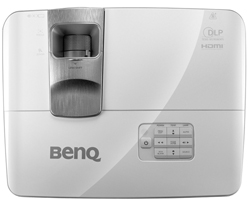
Before you set up the BenQ, you’ll need to pay attention to where you can place it. In addition to the offset from the screen that is required, the lens zoom is fairly limited as well. It isn’t wide enough to work for zooming between 16:9 and 2.40:1 ratios, and you’ll have a limited area that you can mount the W1070 to have it completely fill your screen. If you are ceiling mounting this probably won’t be an issue, but it can be for tabletop use. Once I positioned the BenQ next to the ceiling on my rack, I calibrated both ISF and User modes, and then sat down to watch some content.
The BenQ W1070 Projector In Use
Monsters Inc. from Pixar is a wonderful demo disc, with bold, bright colors and lots of fine detail in the textures and fur of the monsters themselves. The 3D version from Pixar keeps all of this intact but adds a lot of depth, making it a challenge for a projector to display. Watching it on the W1070, crosstalk is virtually absent, and the image still has a significant amount of pop even with the active 3D glasses. Many scenes extend deep into the background, with the 3D effect being very effective, and the vivid colors maintain all of their pop behind the active glasses, even without calibrating for 3D. If you remove the 3D glasses you might notice a red tint to the image, but the glasses take that into account and you won’t see it when watching. The updated 3D glasses from BenQ are far more comfortable than before, and watching a whole Pixar film was easy and enjoyable to do.
A harder test for 3D displays and projectors is Hugo. Making the task more challenging is the fact that its live action with objects that extend from the screen instead of just adding depth to the image. There are also many scenes with fast action and quick cuts that often cause 3D projectors to have copious amounts of crosstalk and artifacts. Even with these challenges, the BenQ handles the title with aplomb, keeping the film easy on my eyes and the experience headache free.
The initial zoom into the train station with snowflakes is very nice, as those snowflakes usually cause a huge problem with lesser projectors. A quick cut to the station inspector’s dog at the start also usually breaks up badly, but the BenQ had no issue with it. The initial chase scene through the station is very fast, with multiple quick cuts, but it wasn’t a problem for the W1070 to handle at all. The image remains detailed, colorful, and really bright while popping out of the screen surface. For 3D, the BenQ is great and well ahead of non-DLP projectors.
The Insider has a wonderful transfer, but the cinematography is a bit darker and muted in comparison to Hugo and Monsters, Inc. This stylistic choice causes a little bit of a problem on the BenQ, as the higher black floor on it causes a little bit of black crush with some dark suits, and some shadow areas to not be as detailed as they could be. Fine detail on the BenQ is superb, with facial lines and hairs showing up for all to see as single-chip DLP projectors are almost impossible for a three-chip projector to beat in this area. Outdoor scenes maintain their pop and clarity, but some interior scenes come out a bit murkier on the BenQ as the lack of the dynamic iris present on the more expensive W7000 shows up here.
The Dark Knight Rises is also full of very dark, shadowy areas, but holds up much better than The Insider on the W1070. Nighttime and sewer scenes have plenty of shadow detail, and I never found myself unable to see details that I know to be present. Fast action scenes are great as DLP is fantastic with motion handling, and the only blur that was visible on quick cuts and pans was due to the film itself and not the projector.
Switching over to Argo, I never regretted not seeing the film in theaters instead of at home. From the opening scene until the end there is a very nice, film-like quality to the BenQ image and the look of the film is very complementary to the projector. Scenes that are clear and sharp look amazingly realistic on the BenQ, while it also exposes those that are a bit softer in focus. There aren’t many bright, bold colors or dark, shadowy scenes here, but there is a wonderful image and environment that the BenQ does a perfect job of capturing.
There are a couple issues I had with the BenQ while I was watching films. The vent for the projector is in the front, and I can see a bit of light falling on the sidewall while watching a film. It isn’t a huge issue, but I wish they had put the vent on the rear of the unit to prevent this light leakage. It also is not a silent projector, and even on Economy lamp mode I could easily hear it when it was above my head. The small form factor of it likely means a smaller fan to cool it, which then has to spin faster and with a higher pitched sound we can hear. These aren’t deal breakers at all, but they are small detractions.
Overall the BenQ presents a very nice image on screen that will make most people very happy. Pixel fill from the DLP chip is very high, with individual pixels only visible when right up against a 120″ screen, and sharpness was very good. 3D was again way ahead of LCOS and LCD models, with no crosstalk and a much brighter image. Transfers with darker, more washed-out images presented a bit of a problem as the higher black levels and lower native contrast ratio of the BenQ began to lose a few shadow details, but most films looked wonderful.
The BenQ W1070 Projector On the Bench
The BenQ W1070 was calibrated using CalMAN 5.1 and i1Pro and C6 meters. ISF and User modes were both tested, and both produced incredibly similar results, so you can calibrate the BenQ without needing an ISF technician.
The best mode uncalibrated was the default User mode. It had the best grayscale numbers, and the best color numbers as well. When using the HDMI input, color and tint controls are disabled, so unless you have calibration equipment, all that you will be configuring on the BenQ are the brightness, contrast, and sharpness controls. Setting those is much easier when Whiter-than-White and Blacker-than-Black are visible, but those are clipped by default. They can be made visible by setting the HDMI Mode to PC from Auto, which I would recommend doing.
I’d also recommend sending all your content in the YCbCr 4:4:4 colorspace. Using 4:2:2, the BenQ used lower quality filtering on chroma detail, and the timing was misaligned by half a pixel. Using RGB produced similar results, but 4:4:4 was handled properly and should be used if possible. Once these are set correctly, the default User mode provides very respectable out-of-the-box performance, though one that calibration certainly improves. The grayscale is really good in User mode, and the gamma was close to 2.2 using the 2.4 setting on my screen.
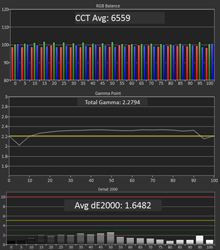

Colors are decent, with a high amount of red error that leads to a bit of redness in some images before calibration. There are no Color or Tint controls to use with an HDMI signal, so this is the best you can do unless you do a full calibration with the proper equipment. The color checker chart is also very good for a non-calibrated display.

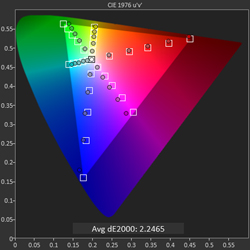

After calibration, I found I got the best results with Brilliant Color enabled, but enabling this without calibrating is a bad idea, as it over-saturates everything. After we enable it and calibrate we can get a pretty good grayscale, though the 2.2 gamma setting tracks a little low at 2.1 overall but I found the 2.4 setting to be too dark. You can’t get the calibration perfect, as the Hue and Saturation controls interact with each other, but it still results in a much better image than before calibration. The blue error was acceptable as this is the color where errors are least visible, and having a higher error there with smaller errors in every other color still looked better to my eyes than the initial settings. Calibrating with Brilliant Color off shifts that error to red and green instead.




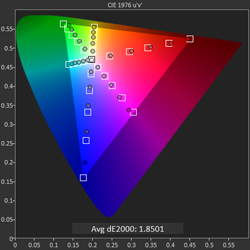

Measuring off the screen, I had contrast ratios of right around 1000:1 from the BenQ, with white output up close to 50 fL on my screen. Using a different method for measuring contrast, which removes the screen as a variable and tries to account for ambient light (which exists even in a darker room), I measured 1530:1 for the BenQ. I believe the latter method is more accurate and so I would say it has a calibrated contrast ratio right around there, and I will use this method for future projectors as well.
With Brilliant Color enabled, the greens are a little over-saturated, but without it they and red are both under-saturated. Looking at the two back and forth led me to just slightly prefer Brilliant Color, as there wasn’t a noticeable green push to it. After calibration, I managed to have 1126 lumens in Economic mode, and 1683 in Normal lamp mode. In the preset Dynamic mode, with the lamp on normal I measured an incredible 2244 lumens. This mode is very blue, so I wouldn’t want to watch it, but it is very bright. Almost 1700 lumens calibrated should make everyone happy, as the BenQ is really bright.
One new testing method I’m introducing here with the BenQ is the uniformity of the light output. Almost all projector measurements are made at the center of the screen, where the lens is ideal, but measuring around the screen really tests the quality of the lens as well, which most people take for granted. The upcoming new Spears and Munsil disc has a 13-point uniformity pattern, modeled after EBU Tech 3235. Here I will measure 13 points across the screen using a light meter, so I’m reading from the projector and not off the screen. Then I can input these into Excel and calculate the overall uniformity.

Here we see that one side of the BenQ is really much darker than the other. Light fall-off goes down to as little as 54% of the center at the corners, a noticeable drop-off. Compared to the median measurements, the high and low values vary by +33% and -28%, a fairly large spread. I also measured this last year on the Sony VPL-HW50ES projector, but as it was the first to have it done, I didn’t report it to have some comparable data first.
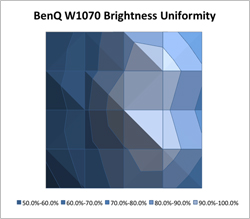
The Sony variance is only 9%, in comparison to 20% on the BenQ, with the lowest output falling to 75% of the center. Good glass is expensive, as anyone that has an SLR camera knows, and cheaper glass often has light fall-off on the edges as we see here with the BenQ. This isn’t unexpected, it’s just something that we haven’t measured before, but I will going forward to help differentiate the lens quality on projectors as well.
On test patterns, the BenQ failed to handle 2:2 cadences correctly, but handled 3:2 and 24p for deinterlacing just fine. Jaggies were handled only fairly, with the synthetic tests being OK but video tests showing very noticeable issues with jagged lines. There was no pixel cropping, and BTB and WTW were handled correctly if you used PC mode as I mentioned earlier. My advice would be to have your Blu-ray player send 1080p signals in the 4:4:4 colorspace to get the best performance out of the BenQ W1070.

Using the Leo Bodnar lag tester, I measured 33.65ms of lag for a 1080p signal, or almost exactly two frames at 60 frames per second. For most gamers this will probably be quick enough.
Conclusions about the BenQ W1070 Projector

While the BenQ W1070 has some issues, almost all of them are the things you need to do to bring out a projector at the $1,000 price point. Some light drop-off at the corners and some more placement restrictions are what you will have to deal with, though if you can position the W1070 in your room fine, there is a good chance you won’t really notice the uniformity issues. It has a few flaws, but none are deal breakers to me.
For 3D, it’s going to be impossible to best the BenQ at this price I believe. Depth, crosstalk, and brightness were all outstanding, and the glasses are better than the last version from BenQ. The 2D image that it puts out is very nice as well, with great motion, very good detail, and very nice color after calibration. Rainbows were sometimes visible if I really tried, but they never bothered me, and I believe that many people might not see them at all. If you are very sensitive to them you probably will still see them sometimes and you should make sure to test it out first.
I’m supposed to be really critical and demanding as a reviewer, but after watching the BenQ for a few weeks, most people I know would be very happy to have it in their homes. Almost my entire family was over at my house for a party, and in small groups they kept making their way to the home theater as I’d installed new seating they wanted to check out. With a film playing on the W1070 as they came in, everyone left impressed with the image, and not a single one said, “That’s nice, but…” They just left impressed. The BenQ W1070 is bright, has a great image, and is cheap. If you want an incredibly affordable way to get a huge, good-looking image in your home, the BenQ W1070 is a fantastic way to do so, and one that I highly recommend checking out.


